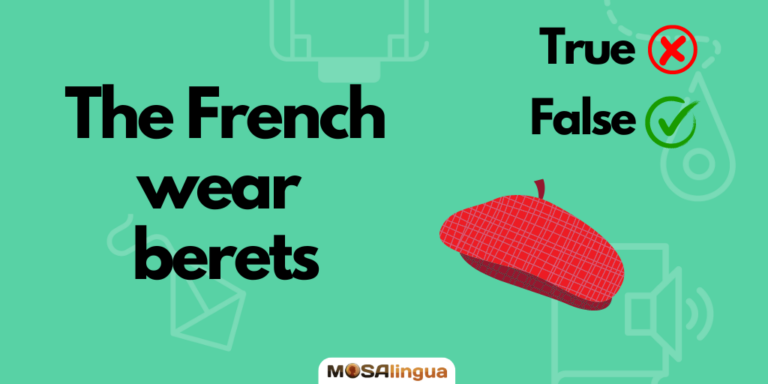If you’ve been learning French or are simply a fan of French culture, I’m sure you’ve come across some clichés about France and its people. But just like all nationalities, clichés are often stereotypes that don’t really reflect reality. So today, we’ve decided to look a little closer at a handful of French stereotypes, explore where they might have come from, and set the record straight!

Vrai ou Faux? Which of These French Stereotypes Are Based in Reality?
The French have bad hygiene 😷
During my first trip to the United States, a new acquaintance casually asked me, “So, you really don’t shower?” 😳
Shocked to say the least, I tried to sneak a sniff of my perfectly fresh-smelling armpits. But yes, it would seem that the French have a reputation (at least across the Atlantic) for not showering very often, and instead just giving a quick spritz of perfume or cologne before going about our day (ew). There’s even a saying that some Americans use – “having a French shower.”
So… do French people shower? Yes!
This is just the first of several false French stereotypes! At least in modern times. Because, like many stereotypes, there is a small grain of historical truth.
The “French shower” was normal practice during the Middle Ages and up through the French Revolution. No, the members of the French court weren’t the cleanest bunch.
Bathrooms and toilets didn’t really appear until the 19th century, so people just kind of made do… They had perfume to cover their bodily odors, and fans to clear the air!
Totally vrai or just a cliché? A CLICHÉ ❌
France is the country of love 😍
Edith Piaf’s “La vie en rose” plays in the background while Marc takes Sophie for a stroll along the Seine. They board a bateau-mouche for a romantic candlelit dinner. It’s cold; he gives her his jacket and looks deep into her eyes while quoting a poetic phrase from classic literature… 😍
No, dear friends, this is just another French cliché!
Of course, the French can be very romantic, but the idealized montages that appear so often in films are just that – fiction.
What’s more, if you’re in Paris and you see a man get down on one knee to propose at the foot of the Eiffel Tower – spoiler alert! – I guarantee he’s not French.
To learn a little bit more about the realities of romance in French culture, watch the video below: French Romance: Myth or Reality? It was produced by a French news network and is in French. French subtitles are available.
Totally vrai or just a cliché? A CLICHÉ ❌
The French drink lots of red wine 🍷
Loving wine in France isn’t a cliché, it’s a national passion!
Why is it so hard to resist a glass of wine in France? Quite simply because French wine represents an art form all its own. The French know how to take the time to appreciate a good glass of wine, savor it, accompany it with delicious dishes, and share convivial moments around the table.
Meals are considered moments of pleasure and sharing, and wine is often at the heart of these occasions.
Moreover, one of the fascinating aspects of French wine culture is the concept of “terroir.” Terroir refers to the unique combination of soil, climate, and local practices that gives each wine its distinctive character. In France, each wine-growing region has its own terroir, which helps to create an incredible diversity of wines across the country.
It’s simply part of French culture to appreciate and take an interest in these riches.
So, cheers!
Totally vrai or just a cliché? VRAI ✅
Start improving your French today
Good news: we can help!
More good news: you can get started for free! With your free trial, you can test drive the most effective method for learning French for the next 15 days!
Vocabulary flashcards, videos with subtitles, audiobooks, articles adapted to your level – with MosaLingua Premium (Web & Mobile), you’ll have access to all this and more. Get started right now. It’s free—and risk-free—to try!
The French only speak French 🇫🇷
There are many stories out there about tourists who have bad experiences dealing with locals. Is it true – are French people rude?
It seems that often the root of the problem is communication – or lack thereof.
For a long time, many French people had little knowledge of other languages. This was due to various factors: foreign languages weren’t often taught in schools, and foreign films were almost always dubbed into French. So, in those days, the average French person wasn’t really exposed to other languages, either in daily life or at work.
But things have changed a lot.
Although there’s still a long way to go in terms of language learning at school, it’s now mandatory in middle school.
The arrival of the internet has also played a key role in English language learning especially. Young people are more motivated because they want to communicate with the world, while adults need certain skills in their professional lives. Also, unlike previous generations, we have the opportunity to explore the world at our leisure. And to do that, we need to be able to communicate.
In short, today it’s a cliché to say that the French only speak French. They have made a lot of effort in recent years to keep up with the times.
Totally vrai or just a cliché? A CLICHÉ ❌
French fries are actually French 🍟
They’re called French fries in the U.S., so Americans must be convinced that frites are French.
In Belgium, on the other hand, it’s a different story! Fries are said to have originated in Belgium, and thus should be called Belgian fries on the other side of the Atlantic.
Though this culinary dispute between the French and Belgians over the origin of fries continues, food historian Pierre Leclercq (100% Belgian) maintains that fries are indeed French. According to him, they originated on the streets of Paris street in the early 19th century, before being exported to Belgium.
So the origin is definitely French, even if frites became an emblematic Belgian dish in the 20th century. Watch the full explanation in this video by @brutofficiel.
Totally vrai or just a cliché? VRAI ✅
The French are always on strike 🪧
“Why do the French always strike?!” A reasonable question, especially after the recent gilet jaune protests in 2018, and then those against pension reform in 2023. Wikipedia even has a detailed chronology of social movements in France, divided into 3 eras: medieval, modern, and contemporary.
So, with strikes starting as early as 1229, and an online calendar of the next 2023 strikes to come… let’s face it, the French go on strike a lot. Reality ✔
However, despite the fact that they always seem to be on strike, it’s not because French people are lazy – they simply want to defend their rights.
Throughout history, public demonstrations have been ingrained as a valuable representation of the right to expression, which is a pillar of French society. It’s a symbol of the struggle for social justice and equality, an important characteristic of the French ethos. Indeed, the French Revolution of 1789 demonstrated that people could change things by protesting.
Strikes are in fact a means of protecting workers’ rights, not a series of protests to work less.
Totally vrai or just a cliché? VRAI ✅
The French eat croissants for breakfast every day 🥐
You might have an image of a French person having breakfast on the balcony of their apartment with a view of the Eiffel Tower (even if they don’t live in Paris). And of course, the essential ingredient to complete this idyllic image – a buttery croissant.
Yet another French stereotype.
Don’t get me wrong, the French do eat croissants, but not every morning. They’re more often reserved for a weekend treat: 75% of French people report eating croissants with their breakfast during the weekend, whereas only about 45% said that they eat croissants during the week.
Above all, the croissant is an occasional indulgence.
And they’re not just eaten in the morning. Particularly among children, croissants are a popular afternoon snack.
So whether you’re having breakfast or a midday treat, any time is a good time to visit the bakery. Once you’re there, you’re bound to be tempted by the glistening, gold-brown crescents! Just like 85% of croissant consumers.
It’s easy to see why the supermarket isn’t France’s favorite place to buy their favorite viennoiserie (flaky pastry). That’s right! According to an IFOP poll (the French Institute on Public Opinion), 3 out of 4 respondents reported eating croissants, and the French prefer purchasing their croissants fresh at a boulangerie (rather than from grocery stores).
The same study found that croissants were the second most popular purchase in boulangeries (keep reading to find out the #1 most stereotypical French food)!
Totally vrai or just a cliché? A CLICHÉ ❌
The French wear berets 👨🏻🎨
It’s a known fact that the French all wear red berets, proof of supreme Parisian elegance… Well, not really.
Sorry, folks, it’s a cliché!
The red beret, as you know it, is an accessory typically used to reinforce the image of the stereotypical Frenchman in films, illustrations, newspapers, and so on.
The black beret, on the other hand, has graced many a gentleman’s head since the 19th century. First, it was worn by Béarnese and Basque shepherds, then by sailors, soldiers, and others. Its function was protective, not aesthetic. But it eventually became a popular accessory not only among the French but also for artists and fashion designers around the world.
If you see one on the streets of Paris today, it’s probably a tourist or the rare French enthusiast. Generally, you’re more likely to find them in the countryside, worn by older men.
In conclusion, in this day and age, yes, a few papis (grandpas) wear berets, but not enough Frenchmen do to make it a cultural statement.
Totally vrai or just a cliché? A CLICHÉ ❌
The French love horizontal stripes 🦓
The marinière is one of France’s most popular symbols – both a fashion staple and a piece of cultural identity.
What started as a French naval uniform took civilian fashion by storm thanks to the creations of Coco Chanel, Jean-Paul Gaultier, and Yves Saint-Laurent.
Today it represents the symbol of casual elegance.
Whether voluntarily or not, it seems that every French person has at least one shirt with horizontal white and navy stripes in their wardrobe. Of course, they don’t pair it with a red beret and a scarf around their neck…
The marinière is simply a tastefully elegant, yet casual garment that goes with everything. And in France, nothing beats casual chic! 100% reality ✔
Totally vrai or just a cliché? VRAI ✅
French women don’t shave 🪒
Today, whether women in France, Italy, Japan, or anywhere else decide to shave (or not), it really just boils down to personal choice.
Standards of beauty are constantly evolving, and today more than ever, people are celebrating their bodies in many different ways.
There is a whole list of stereotypes about the French and their personal hygiene. But is this one a cliché… or reality?
Can we really estimate how many women shave (or don’t)?
Apparently so: Gillette France has a frighteningly detailed website that details the shaving habits of French men and women. And yes, I do mean scary, because I had no idea that so much information about shaving was available.
Anyway, after much eyebrow-raising, we can now say that 63% of French women consider unshaved armpits embarrassing. So, cliché alert! (Most) French women shave.
Totally vrai or just a cliché? A CLICHÉ ❌
French people always walk around with a baguette under their arm 🥖
Always? No. But often, yes!
It’s not hard to guess where this French stereotype comes from. The French and baguettes – it’s a real match made in heaven.
We love them, we idolize them… So much so, in fact, that the making of baguettes and the culture surrounding them was named to UNESCO’s list of Intangible Cultural Heritage in November of 2022. The UNESCO Committee declared that it is “the type of bread most appreciated and consumed in France throughout the year.”

How many baguettes do you think are sold in France in a year? 100 million? 500 million?
Hold on to your berets – the real answer is 10 billion!
That’s over 27 million baguettes per day.
So, with so many baguettes circulating in France, there’s a good chance you’ll come across a Frenchman or Frenchwoman with a baguette under their arm. After all, you’ve got to take it home somehow…
And let’s not forget the classic photograph by Willy Ronis, famous for documenting post-WWII France through his candid images.
Image source: leparisien.fr
Totally vrai or just a cliché? VRAI ✅
The French eat snails 🐌
Yet another common cliché about French eating habits: they do eat snails.
Cooked snails, of course, just in case you’re wondering… (No, we don’t just pop into the garden for a quick raw snack.)
Most French people have tasted a snail at least once in their lives. But did they like it? You can’t deny that it’s an acquired taste. And not everyone is fond of this peculiarly textured mollusk.
It is, however, part of French gastronomic culture.
The French find escargots on their plates at holiday meals, most often around Christmas and New Year’s.
We eat them à la Bourguignonne with garlic, parsley, and butter.
Provençal style with tomato sauce, peppers, onions…
And in the south of France, near Spain, we even organize cargolades, a festive Catalan summer custom. These are small snails cooked in lard and spices, grilled over an open fire.
Totally vrai or just a cliché? VRAI ✅
BONUS Video: French Stereotypes Debunked by Real French People
For a fun, theatrical look at these stereotypes, check out this video. It stars Cédric and Lucie, two members of the MosaLingua team who just happen to be French, and who have something to say about these generalizations about their fellow citizens! Find out which of these stereotypes they are guilty of!
The video is in French, but they speak slowly. If you need subtitles (available in French, English, and four other languages) or want to slow the video down, just click the gear button in the bottom right corner of the screen.
Subscribe to our YouTube channel for more fun content about language!
Next Steps
If you’ve enjoyed this article about French stereotypes, you might also like:
- 30 Useful French Idioms to Spice Up Your Expression
- Different French Accents Around the World
- 15 Fun Facts About French (#11 Isn’t “Fun” At All!)












Comments